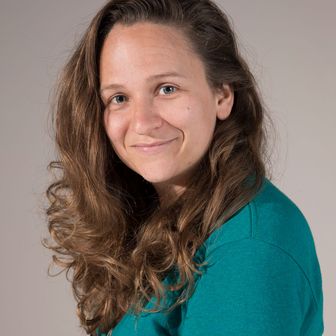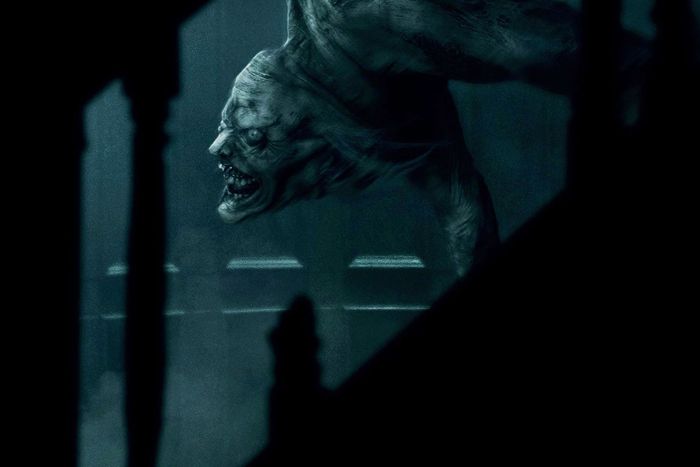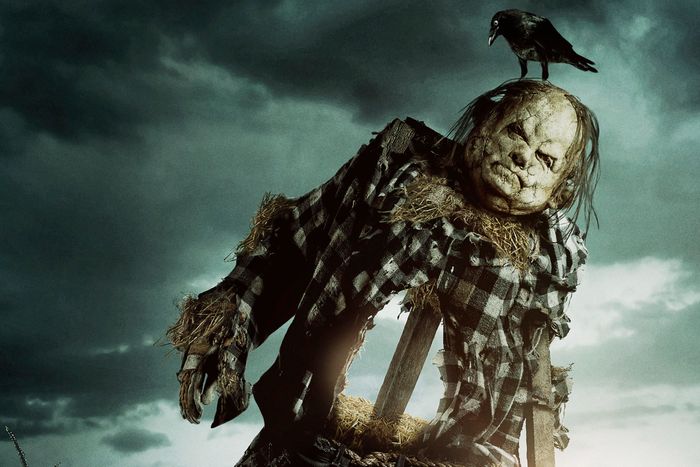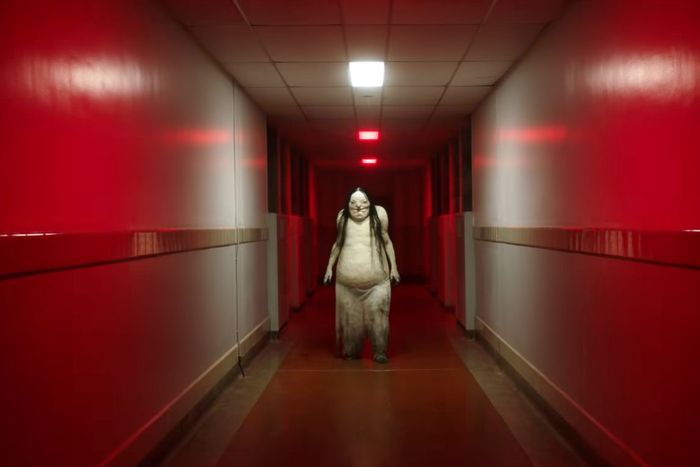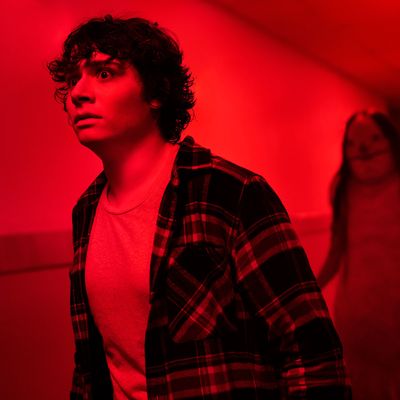
Adapting any popular children’s book for the screen is a lofty endeavor, but Scary Stories to Tell in the Dark posed a unique challenge. The original book series by Alvin Schwartz is most famous for Stephen Gammell’s grotesque illustrations, visions of creatures that seem to have materialized out of evil mist, straight from a whirlpool of nightmares and onto the page. There’s the ghost of Aaron Kelly, the rotting woman from “The Haunted House,” the deformed rat from “Sam’s New Pet.” They all possess a specific visual signature that Scary Stories producer Guillermo del Toro and director André Øvredal knew they needed to re-create faithfully if their movie was going to land with fans.
Fortunately, del Toro and Øvredal both know their way around a monster. The Oscar-winning Mexican filmmaker has built his career on making impossibly hellish creatures feel possible (Pan’s Labyrinth, Mimic, Hellboy), and Øvredal, who is Norwegian, broke out with his documentary-style chronicle of a Nordic myth, Trollhunter. To bring their patchwork of torment to life, del Toro hired a dream team of creature creators — Mike Hill, Mike Elizalde, and Norman Cabrera — and instead of building the monsters via assembly line, each person was given a ghoul to oversee from the beginning of production to the end, including supervising and modifying the live actors and their costumes on set.
Vulture spoke with del Toro and Øvredal about what the producer has dubbed a “young adult” horror movie, and dug into how they brought Gammell’s gossamer-thin sketches into its three-dimensional world.
The Jangly Man
The Jangly Man is the only hybrid creature in Scary Stories. To create him, the filmmakers pulled from a few of Schwartz’s stories to make what del Toro calls “an amalgam” of various specters. There’s a bit of “Me Tie Dough-ty Walker,” which is the refrain that the Jangly Man repeats when he appears to terrorize one of Scary Stories’ young protagonists, Ramón (Michael Garza). The Jangly Man enters the film by falling down a chimney in pieces, his waxy head arriving first, followed by his severed limbs, and finally, with a thump, his torso, echoing the original sequence from the book. But once the chunks of body assemble into a whole man, del Toro says his complete form was inspired by the limber dancing corpse from the tale “Aaron Kelly’s Bones,” which was meant to evoke the trauma Ramón experienced after losing his older brother to the war in Vietnam.
“Originally we thought he would have eight legs,” del Toro explained. “It will be the representation of all the body parts that came back from the war, like when Ramón says, ‘My brother came back in pieces,’ you know?” But the eight-legged concept would have required too much digital retouching, and the filmmakers wanted as much to be done practically and in camera as possible. Fortunately, they had something of a secret weapon in the actor Troy James, often referred to as Twisty Troy because of his skill as a contortionist. Del Toro had previously cast James as a demon hound in the series The Strain, and he’s also stolen scenes with his Gumby-like body as Pretzel Jack in Channel Zero: Dream Door and this year’s reboot of Hellboy, in which he played the child-eating Baba Yaga.
One of James’s most famous moves is his ability to quickly and fluidly crabwalk while twisting his shoulders and hips into unfathomable positions, as though his body were double-jointed at every nexus. For Scary Stories, Hill made a plaster cast of the actor’s body to create two body suits from the mold — one for standing Jangly Man and his upright face, and one for crawling Jangly Man, whose head is twisted upside down atop his neck. While crawling, James’s vision was obscured because the eyes of the mask were placed on his chin. This made rehearsal time crucial.
And, yes, when you see the Jangly Man crawling up some prison bars, that was indeed James hoisting himself up using his own strength. Relying on his actor’s physical abilities, Øvredal imagined the character as more than just a “force of destruction,” but as a living thing capable of feeling sincere agony. “I was very preoccupied with making sure that you feel his pain when he’s growing together and you’re hearing how he behaves, all the cracking and that he’s painful in his breathing and everything,” said the director. “We talked a lot about the balance of making him not just an evil monster, and actually a living creature.”
Harold
If you’ve committed Schwartz’s books to memory, you’ll notice, upon watching del Toro and Øvredal’s adaptation, that Harold the scarecrow is missing his paunch from the original Gammell drawing. Instead, he sports a large hole in his straw-filled torso. In an earlier iteration of the movie, Harold was indeed bearing the belly, but the filmmakers eventually decided it looked too friendly to keep onscreen. In the final version of Scary Stories, he still has his classic splayed legs, doughy demeanor, and permanent grimace. His creature master, Cabrera, experimented with burlap for the face, but didn’t like the look, settling instead on re-creating the withered appearance of an old latex Halloween mask, with a decomposition pattern that made it look like Harold wore a face made around the 1940s. The movie takes place in 1969, giving the sense that the latex had a few decades to artificially age into something that looked like human skin.
Most monsters in Scary Stories don’t actually kill their victims in the source material, but Harold does, and in pretty gruesome fashion. In Schwartz’s story, Harold gets so fed up with the abusive farmers keeping him that he ends up killing one and spreading his stripped skin out on the roof of the house to let it dry in the sun. Without spoiling too much, let’s just say Harold’s murderous endeavors are slightly different in the film. This is big-screen horror for kids, after all, and while the cinematic Scary Stories monsters are frightening, it’s still PG-13 fare — that runs less than two hours long. To make the most of Harold’s camera time, the filmmakers chose not to have him pace about, as he does in the books, but instead dismount from his pole and advance in specific halting movements. As a result, you only see him in motion in a few quick shots, forcing your mind to fill in the blanks of his key sequence of pursuit. Fewer elaborate movements also meant less need for a CGI paintbrush to smooth out his action.
“It’s a very difficult balance because you have this wonderful creature, so you want to show off to the audience,” says Øvredal, who was frightened on set multiple times when he’d catch Harold’s creature actor walking around in full makeup. “At the same time, you know the Alien idea that the less you show, the scarier it is. So it’s keeping him at a distance and then every now and then letting him get his close-up when it really matters.” The elusiveness almost helps intensify the punch when Harold goes from stiff steps in and out of cornrows to running someone through with his pitchfork.
The Pale Woman
Even though Harold gets prime placement on the Scary Stories poster and the Jangly Man is the most active antagonist in the film, the Pale Lady is the creature most capable of searing a long-lasting image in your brain. She originated in Schwartz’s story “The Dream,” in which the Pale Lady serves as a foreboding but static presence, warning the subject of the story to flee. The story’s accompanying illustration is also one of Gammell’s most famous, featuring a grayish-white heap of a woman whose round head emerges from a formless body with high shoulders. Her hair is wispy and thin, and her face is bisected by a long, flat mouth that betrays the slightest hint of a grin. Her eyes are wide-set, beady, and black.
The film version of the Pale Lady is a remarkably similar re-creation, and posed one of the biggest challenges for the filmmakers: How do you make images that are so dreamlike and translucent — drawn in “tendrils of ink” as del Toro puts it — feel substantial and threatening onscreen? The producer says the micro-expression on her face — that causes her to seem at once “cute and shy” but also “inexorable” and menacing — was extremely difficult to sculpt. As were her sickly looking garments, which del Toro and his team chose to render as a kind of epidermal growth. “One of the early decisions was that her nightgown would emerge directly from her skin,” del Toro explained. “And I knew that she had to have an embrace that would be supersoft. But then we gave her these really harsh hands and sort of muscular arms, all with the benign expression, because that’s what’s in Gammell’s drawing.”
Within the foam latex suit that makes up the Pale Lady’s body, microspheres of padding were used to create the look of cellulite in motion. The actor underneath was told to make the creature seem “coy” in her movements — all while fighting the sweat of wearing thick foam. To make such a slow-moving object feel dynamic and threatening, Øvredal staged a complex series of shots as the Pale Lady closed in on her prey. Del Toro says her scene was the closest of all the vignettes to feeling like a dream.
“I wanted it to be like a relentless machine coming toward you, and confusing to the character. Is this a dream? Is this reality? What is real here?” says Øvredal, who had to meticulously map out the scene’s dizzying cuts — switching back and forth from one direction to another in a uniformly bright-red series of hallways — before he actually started to roll film. “It was extremely carefully planned out how every edit and every in point and out point of every shot had to work. We wanted to be very elaborate with the storytelling, but she was going to be the calming, creepy thing that just keeps going.”


